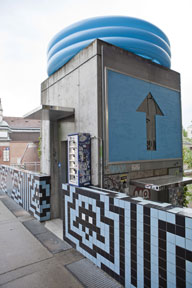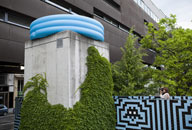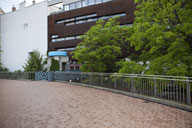Deep Inc. (A)25.05. – 26.07.2012
Das Künstler-Kollektiv Deep Inc. kratzt gerne an Oberflächen und legt mit Interventionen versteckte Potentiale frei, die in unserer alltäglichen Umgebung schlummern. Für Aufsehen haben sie zuletzt mit ihrem preisgekrönten Großprojekt Intervention_F1, einer Arbeit auf dem Dach der Wiener U-Bahnstation Hietzing, gesorgt. Wenig überraschend gestalten sie für die Street Art Passage auch nicht einfach nur ein Bild: Für zwei Monate lang wird ein aufblasbarer Swimmingpool auf dem Liftturm der Passage installiert.
Vom klassischen Graffiti Bombing bis zur Land Art scheint ihr euch in allen künstlerischen Ausdrucksformen wohl zu fühlen. Ihr zeigt eure Arbeiten in Galerien und geht nachts auf die Straße. Seht ihr euch selbst als Street Art Künstler?
Wir waren lange unglücklich mit dem Street Art Begriff. Wir haben zwar einen Graffiti Background, aber wir sind davon abgekommen, ein Logo zu reproduzieren oder mit unserem Namen um fame zu kämpfen. Graffiti ist Adrenalin, öffentlicher Raum, Illegalität. Geht man von diesen Grundzügen aus, hat es in Galerien sehr wenig zu suchen. Wir sind an einem Punkt angelangt, an dem das Projekt und die dahinterliegende Idee wichtiger sind als die Illegalität. Aber: Wenn es legal nicht geht, dann machen wir es illegal. Unser Ansatz ist dabei, individuell Konzepte für den jeweiligen Ort zu entwickeln. Wie bei der Intervention_F1 in Hietzing, wo wir das Flugdach der U-Bahnstation, das durch seine Architektur formale Ähnlichkeiten zu einem Rennbahnoval aufweist, in ein genau
solches verwandelt haben.
Durch das Aufbringen von Straßenmarkierungen …
Das Interessante dabei ist, dass diese Rennbahn nur von ein paar höheren Gebäuden der Umgebung und auf Luftbildern zu sehen ist. Für uns hat die Sichtbarkeit keine Priorität, sondern die Intervention an sich, die einen neuen Raum, einen neuen Gedankenraum öffnet. Es ist schön, wenn man durch die Stadt geht und sich mit kindlicher Fantasie überlegt, was alles möglich wäre. Unsere Nachricht an alle lautet: "Es könnte alles auch ganz anders sein". Jeder und jede kann diese Freiräume denken und schaffen.
Verhält es sich mit dem Pool im MQ ähnlich?
Prinzipiell geht es auch hier um den gedanklichen Freiraum und um individuelle Assoziationen. Wir wollen mit dem Pool keine plakative Aussage treffen. Natürlich ist es absurd, ein Schwimmbecken in dieser Höhe aufzustellen – gleichzeitig hat das Ganze eine gewisse Poesie.
Poetisch waren auch eure Schatten-Fahrräder.
Ja teilweise, wichtiger war uns bei diesem Projekt allerdings der kritische Aspekt. 2002 haben wir 1:1 Abbilder der Gratisräder gesprüht. Mit diesen "Schatten" wollten wir die sehr schöne, aber letztlich gescheiterte Gratisräder-Aktion der Stadt Wien als gesellschaftliches Experiment deuten. Wien war nicht bereit für gemeinschaftlichen Besitz, was schade ist. Die Idee ist gut, nur die Welt noch nicht bereit.
Interview von Margit Mössmer
The artist collective Deep Inc. likes to scratch beneath surfaces and uses interventions to release unrecognized potentials. They most recently caused a stir with their award-winning large-scale project Intervention_F1, a work installed on the roof of the Hietzing U-Bahn station in Vienna. Not surprisingly, their project for the Street Art Passage is much more than an image. For two months, an inflatable swimming pool will be installed on the elevator tower of the passage.
From classic graffiti bombing to land art, you seem to feel at home in just about every form of artistic expression. You show your works in galleries and at night you go out into the street. Do you consider yourselves street art artists?
For a long time we were unhappy with the term street art. It's true we all have a graffiti background, but we got over the urge to reproduce logos or fight for fame with our names. Graffiti is adrenaline, public space, and illegality. If these are its defining characteristics, it doesn't belong in galleries. We arrived at a point where the project and the idea behind it are more important than illegality. But if it can't be done legally, we'll do it illegally. Our approach is to develop individual concepts for each location. Take Intervention_F1 in Hietzing, for example: since the flat, elliptical roof of the the U-Bahn station is reminiscent of a racetrack, we turned it into just that.
By painting road lines on it …
Exactly. The interesting thing is that the racetrack could only be seen from a couple of higher buildings near the station and in aerial shots. But for us, the visibility of this work was not a priority. The intervention itself was important, because it opens up a new space, a new mode of thinking. It's nice if you walk through a city and use child-like imagination to think of all the things that could be possible. Our message to everyone is, "Everything could be totally different." Everyone can think about and create open spaces like these.
Is the pool at the MQ a similar situation?
Certainly it's also about mental free space and about individual association. We don't want to make a striking statement. It's absurd to set up a swimming pool at this height. At the same time the whole thing has a kind of poetry to it.
Your shadow bicycles were poetic too.
Yes partly, but more important was the critical aspect of this project. In 2002 we sprayed life-size silhouettes of bikes from the free bike campaign on walls in various locations. The shadows were meant to interpret the very nice, but ultimately failed, free bike campaign of the City of Vienna as an experiment. Vienna wasn't ready for joint ownership, which is a shame. Die Idee ist gut, nur die Welt noch nicht bereit.
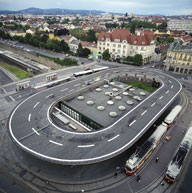 Intervention_F1 auf dem Dach der
Intervention_F1 auf dem Dach der
Wiener U-Bahnstation Hietzing.
Foto: Lukas Beck
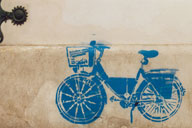 Gratisrad
Gratisrad
